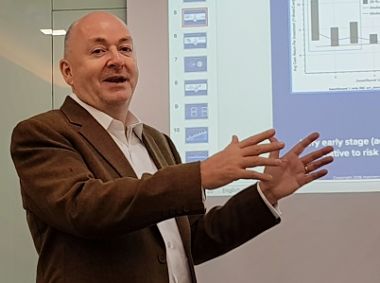|
In venture capital investing, typically you'd put money directly into either start-ups or funds that invest in them.
Hatcher+ plans to raise and invest US$125 million in over 1,000 ventures out of over 130,000 early stage deals. |
Earlier, Hatcher+ had a successful experience with its H1 fund investing US$20 million in 13 start-ups.
It has so far achieved a very high "distributed to paid in" (DVPI) ratio of 0.4, ie through successful exits of its investments, it has been able to return 40% of the money so far to investors.
That places it in the top 10% of all VC funds launched globally since 2012.
Encouraged by the result, yet unimpressed with the traditional VC approach to investing, Hatcher+ sought to find a more scalable and data--driven methodology.
Through various means, it garnered information on 400,000 venture investment deals from the 1990s.
With the data, Hatcher+ created almost 3 billion virtual venture portfolios, ranging from ten companies through to 2,000 companies.
|
Hatcher+ |
||
|
Larger Portfolio |
= |
Better returns |
|
Massive deal network |
= |
Quality portfolio |
|
Earlier investments |
= |
Larger multiples |
|
Traded units |
= |
Flexible liquidity |
|
All these strategies require SCALE and scale requires partnerships with leading expert investor groups worldwide |
||
"What we discovered is that if you really want to make fantastic money out of venture capital, you need to go in at the earliest possible point in a business.
"People say, well, isn't that risky? I would answer that yes, the risk of failure is much greater at formation stage than it is at Series C but the discounting that occurs on valuations more than compensates for the level of risk. In our analysis, we found that the discounting can be up to 80%."
And the portfolio size matters?
"The venture funds that have achieved really solid returns, the guys above the 2.5x line, like Sequoia, NEA, and Y Combinator, all have large portfolios.
"In venture, you get these massive spikes -- when you hit a home run, it may return 200x or 300x your investment. The probability of achieving this kind of this return increases, the more you widen your portfolio."
Comparative analysis:
|
Strategy |
Hatcher+ |
Traditional VC |
|
Deal flow
|
Top accelerators & |
Referrals |
|
Geographic focus
|
Global |
Local
|
|
Selection strategy |
Data-driven (AI/ML + external experts) |
Manual / in-house
|
|
Portfolio Size
|
100 investees / 1OMN AUM |
1-3 investees / 10Mn AUM |
|
Performance monitoring |
Real-time APIs |
Ad-hoc / board seat |
|
Reporting |
Automated |
Manual |
|
LP admin mgmt dashboard |
Comprehensive |
Limited |
|
LP follow-on investment |
Assumed / included |
Ad-hoc / non-prioritized |
|
Resource utilization |
400 Companies / partner |
4 companies / partner |
|
Follow-on strategy |
Seed to Series A |
Double down on winners |
|
Currency |
Multiple |
Single |
|
Jurisdiction |
Multiple |
Single |
|
GP economics |
2 + 20 |
2 + 20 |
|
Liquidity |
ETF structure* |
15 years**C |
|
|
||








